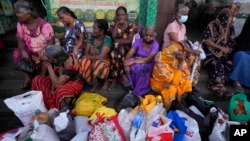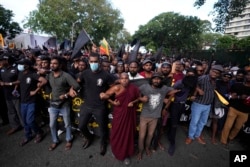Growing economic and political crises in Sri Lanka are pushing more than 10% of its 22 million people beneath the poverty line and millions more are losing jobs, health care and food security, experts say.
“The human development impact of the unfolding economic crisis is severe,” a World Bank spokesperson told VOA. “The crisis has disrupted economic activities and households’ capacity to afford basic necessities, including adequate nutrition.”
Many low-income Sri Lankans have become unable to afford adequate food because of skyrocketing prices with 46% inflation reported in April.
“A worse-case scenario contraction in economic activity in 2022 and 2023 would translate into an increase of over 11 percentage points … with the resulting poverty rate close to 22% in 2023,” the spokesperson said.
The South Asian country is reportedly facing bankruptcy as it has defaulted on its foreign loans for this year, and its foreign currency reserves have plummeted, making it difficult to import fuel and other essential commodities.
While Sri Lanka’s economy has been hammered by the COVID-19 pandemic, with its once lucrative tourism revenues dropping from $5.6 billion in 2019 to $1.08 billion in 2020, its economic woes are rooted in pre-pandemic policies.
“Years of high fiscal deficits, driven primarily by low revenue collection, have led to large gross financing needs and unsustainable debt,” they said.
Economic problems have prompted political unrest in the country 12 years after it ended a 25-year civil war, which reportedly took more than 150,000 lives and caused over $200 billion in economic damage.
For more than 50 days, groups of youth activists and other dissidents have protested outside the President’s House, demanding the resignation of President Gotabaya Rajapaksa. Last week, the police used tear gas and water cannon to disperse the protesters, who tried to enter the president’s office.
The protesters accuse Rajapaksa of corruption and nepotism.
Ranil Wickremesinghe, Sri Lanka’s new prime minister who assumed office on May 12, has promised constitutional reforms, including transfer of some presidential powers to the parliament and inclusion of youth in governance.
Foreign aid, loan
Sri Lanka’s government has sought foreign assistance, including a $3 billion bailout from the International Monetary Fund (IMF), to mitigate the country’s economic challenges.
“An IMF team has been engaging in technical discussions on the authorities’ request for an IMF-supported program,” Gerry Rice, IMF spokesman, said on May 19.
Sri Lanka needs to address its long-standing structural economic weaknesses, including a restructuring of debts for sustainability, the World Bank said.
“Until an adequate macroeconomic policy framework is in place, the World Bank does not plan to offer new financing to Sri Lanka,” a spokesperson for the bank said.
The island nation has also asked China and India for help.
Last week, Prime Minister Wickremesinghe told The Financial Times he was hopeful China would deliver a substantial loan package that will help remedy his country’s immediate market needs.
Sri Lanka already owes more than $50 billion — including $3.5 billion to China — to multilateral lenders, bondholders and foreign governments.
Thus far, China has indicated a “positive” role in Sri Lanka’s talks with the IMF on a possible bailout, according to David Shullman, a China expert at the Atlantic Council.
“At the same time, China has not indicated willingness to renegotiate Sri Lanka’s debt for fear that its many other [Belt and Road Initiative] creditors will demand the same type of concession,” Shullman told VOA.
India has pledged $16 million in humanitarian assistance and $3.5 billion in loans and credit to Sri Lanka.
Some information in this article comes from AP and Reuters.

